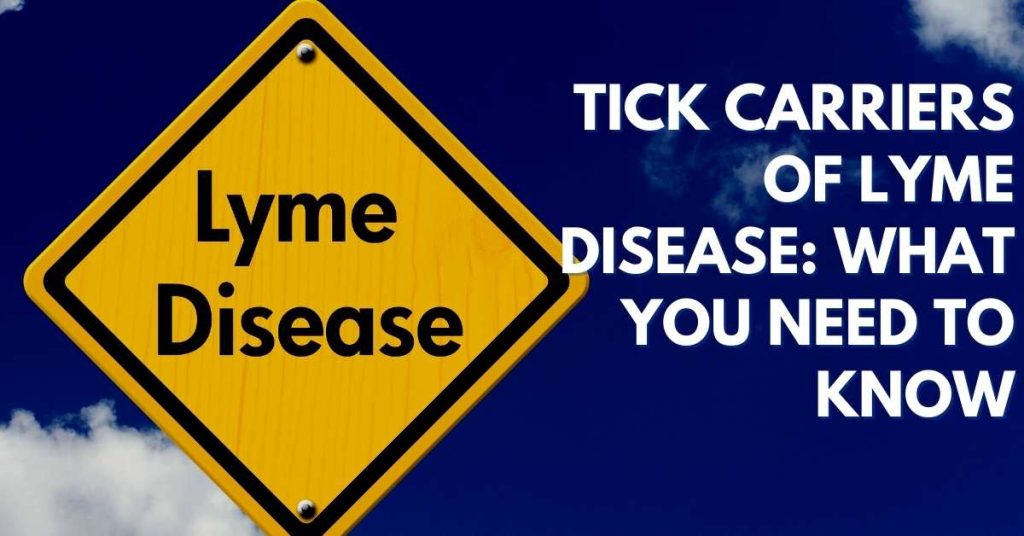
Ticks and Lyme disease are two health-threatening topics people talk about. Not all ticks are carriers of Lyme disease except some prominent tick species – Blacklegged Ticks, Brown ticks, and sometimes Groundhog ticks. Lyme disease is a life-threatening illness that can be difficult to treat if not caught early.
We will look into the different tick carriers of Lyme disease and what you need to do to protect yourself from this life-threatening infection.
What Is Lyme Disease?
Borrelia burgdorferi is a spiral-shaped bacterium that causes Lyme disease. Humans contract this bacteria when an infected tick bites them. Following an unexplained arthritic outbreak in Old Lyme, Connecticut, it was initially identified in the United States in 1975. Since then, reports of Lyme disease have significantly increased, and it now poses a serious threat to the general public’s health.
Four primary bacterial species cause Lyme disease. In America, Lyme disease is primarily brought on by Borrelia burgdorferi and Borrelia mayonii, but in Europe and Asia, it is mainly brought on by Borrelia afzelii and Borrelia garinii. Lyme disease, the most prevalent tick-borne disease in these areas, is spread through the bite of an infected black-legged tick, sometimes known as a deer tick.
Although Lyme disease is a year-round issue, tick season occurs from April through October. The Northeast, upper Midwest, and northwestern states are where cases of Lyme disease are most prevalent in the United States, as well as significant regions of Europe and Asia.
Ticks can attach to any body part, although they are most frequently found in places difficult to notice, like the scalp, armpits, and groin. Most of the time, the tick must be attached for at least 36 to 48 hours before spreading the Lyme disease bacterium.
What Are The Symptoms Of Lyme Disease?
Different people experience different signs and symptoms. The duration of an individual’s infection affects the severity of their symptoms. About 70 to 80 percent of patients develop a ring-like red rash between 3 and 32 days following a tick bite that is infected. The circular red rash that develops at the location of the bite gets bigger for a few days or weeks. The center of the rash, which resembles a bull’s eye, typically clears up. The rash usually doesn’t hurt. This rash may accompany one or more general symptoms, such as fatigue, fever, chills, headache, swollen lymph nodes, neck stiffness, body aches, and joint and muscular discomfort.
An allergic reaction to tick saliva might occur at the tick bite site. These allergic reactions, not symptoms of Lyme disease, often develop 72 hours after a tick bite, rarely reach a diameter of 2 inches, and go away in a few days.
Early Lyme disease symptoms are often misdiagnosed as other illnesses, such as mononucleosis or a flu-like infection without a cough. Many infected people do not remember having been bitten by a tick.
If the condition is not identified and treated, additional symptoms may appear days, weeks, months, or even years later. Some symptoms include high temperatures, excruciating headaches, stiff necks, certain cardiac irregularities, brief facial muscle paralysis, discomfort accompanied by numbness or weakness in the arms or legs, difficulty concentrating or remembering things, and most frequently, Lyme arthritis.
Lyme disease can cause various symptoms, and if left untreated, it can lead to more severe problems such as joint pain, neurological problems, and even death.
How Do You Know If You Are Infected With Lyme Disease?
It’s critical to visit a doctor immediately if a tick bites you. Lyme disease can be treated with antibiotics if diagnosed during the initial stages, so it’s essential to get diagnosed as soon as possible.
A small percentage of tick bites only spreads Lyme disease. Your chance of contracting the illness increases the longer the tick is stuck to your skin. Lyme disease is unlikely to develop if the tick is attached for less than 36 to 48 hours.
If you suspect you’ve been bitten and are experiencing Lyme disease symptoms, especially if you live where the disease is common, talk to your doctor immediately. Early treatment for Lyme disease improves outcomes.
Visit your doctor even if your signs and symptoms disappear. The disease may still be present even if the symptoms disappear. Untreated Lyme disease can cause arthritis and nervous system issues by spreading to other parts of your body months to years after infection. Additionally, ticks can spread diseases, including babesiosis and Colorado tick fever.
How Is Lyme Disease Transmitted?
Deer ticks, commonly called black-legged ticks, carry Lyme disease and spread it through their bite. All ticks do not carry the bacterium, and tick bites may not always cause the development of Lyme disease. It is crucial to prevent tick bites whenever possible because it is impossible to distinguish which ticks are infected just by looking at them.
Deer ticks are relatively small, about the size of a pinhead; mature/adult deer ticks are a little larger. Both have the potential to contract and spread Lyme disease. Deer ticks become infected with the bacteria by predominantly feeding on tiny mammals already affected, mainly the white-footed mouse. The Lyme disease bacteria can infect domestic animals (dogs, horses, and other cattle), and some may acquire the disease.
What Are The Risks For Contracting Lyme Disease?
Your likelihood of contracting Lyme disease can vary depending on where you live or travel. The same is true of your profession (gardening, landscaping, surveying, forestry, and utility service) and your favorite outdoor activities (hiking, camping, and hunting). The most typical risk factors for Lyme disease are as follows:
- Spending time in a grassy or woodland region. Deer ticks are primarily prevalent in the densely forested regions of the Northeast and Midwest in the United States. Mainly at risk are kids who spend a lot of time outside in these areas. Adults who work outdoors are also more vulnerable.
- Exposed skin. Ticks can quickly cling to exposed skin. Hence, wear long-sleeved shirts and long pants to protect yourself and your kids if you live in a tick-prone area. Do not let your pets walk through thick grasses and weeds.
- Not immediately and correctly removing ticks. If a tick is still embedded in your skin for 36 to 48 hours or more after biting you, bacteria from the bite may enter your bloodstream. Your chance of contracting Lyme disease is reduced if you remove a tick immediately or at least within two days.
Ticks are less likely to be present close to clipped, well-maintained plants. You run a higher risk if you live close to or travel through forested or brushy areas.
Where Do The Ticks That Carry Lyme Disease Found?
Ticks that transmit Lyme disease can be found anywhere their hosts exist. They favor damp, shaded locations. The term “deer tick,” frequently referred to the species of ticks that transmit Lyme disease, is slightly misleading. Although deer play a crucial role in the life cycle of these ticks as reproductive hosts, other vertebrate animals (except the deer) are the ones that infect the ticks with disease-causing pathogens. Chipmunks, shrews, white-footed mice, various ground-feeding bird species (finches, blue jay, wrens, American robins, etc.), and several other tiny mammals are among these creatures.
Ticks carrying Lyme disease are present in:
- Tall grasses
- Bushy areas
- Beach grass
- Leaf litter
- Stonewalls
- Woodpiles
- Areas planted with pachysandra or other ground-cover-planted areas
- Lawn borders where they meet garden edges, woodlot, or forest
What Are The Seasons Do Ticks Carry Lyme Disease?
Every age group is susceptible to Lyme disease. In seasons when ticks are most active, your chances of getting bitten by a deer tick are higher. Anytime it gets warmer than 45 degrees Fahrenheit, ticks can become active. From mid-May to mid-August, young deer ticks, known as nymphs, are active. They resemble poppy seeds in size. Adult ticks are roughly the size of sesame seeds and are most active between March and mid-May and between mid-August and November. Nymphs and adults can both spread the illness.
How Is Lyme Disease Diagnosed And Treated?
Lyme disease is challenging to diagnose since its symptoms are inconsistent and can be mistaken for other illnesses. A rash is the main symptom, but it may not be present in up to 20% of cases.
A healthcare professional skilled in diagnosing Lyme disease must make the diagnosis. Symptoms and a tick bite history are typically used to get a diagnosis. Typically, testing is done to validate the diagnosis and rule out alternative illnesses. A blood test and other lab procedures may be required.
Methods for diagnosing Lyme disease are currently being developed and improved through research.
The signs of Lyme disease can resemble those of other illnesses or issues. Always speak with your doctor for a diagnosis.
The treatment course is given based on specific parameters. Your healthcare professional will determine the most suitable course of action depending on your age, present and past medical history, level of illness, capacity to handle a particular medication, operation, or therapy, expected duration of the condition, and your preference or opinion.
In the early stages of Lyme disease, antibiotics are often taken for two to three weeks.
Is Lyme Disease Treatable?
Yes. Patients typically fully recover when Lyme disease is treated early with the proper medications. Doxycycline, amoxicillin, or cefuroxime axetil are popular antibiotics used for oral therapy. Certain neurological or cardiac conditions may call for intravenous antibiotic treatment with drugs like ceftriaxone or penicillin.
Can You Get Lyme Disease Twice?
Can you contract Lyme disease more than once? Yes, you can. Even if you’ve already had Lyme disease (and had it treated), you could develop it once more if you get bitten by a tick harboring the Lyme bacteria. Whether you’ve already had Lyme disease, protecting yourself against tick bites is one of the greatest ways to avoid getting it.
Can Other Bugs Cause Lyme Disease?
Some deer ticks do not carry the bacteria that cause Lyme disease. Even while fleas, flies, and mosquitoes can all carry the Borrelia bacteria, you cannot get Lyme disease from any of these insects.
Animals That Serve As Lyme Disease Hosts
Although ticks may be a vector for the infection to spread to humans, the germs that cause Lyme disease do not originate in insects.
On the other hand, ticks acquire the Borrelia burgdorferi bacteria from other animal hosts and eventually transmit it to people. Although ticks frequently eat on and mate on deer, which is one of the most frequent sources of the bacteria, both nymphs and adult ticks can be found feeding on the following animals:
- Dogs
- Lizards
- Rabbits
- Birds
- Horses
- Squirrels
- Mice
Is There A Vaccine For Lyme Disease?
There isn’t a human Lyme disease vaccine available right now. Years ago, a vaccine was created for use in high-risk locations, but it is no longer accessible.
Preventive Measures Against Bites From Ticks With Lyme Disease
Avoiding tick bites is the most effective strategy to prevent Lyme disease. Ticks are most active in the spring and summer, so it’s essential to take precautions during these months.
- Wear a long-sleeved shirt and slacks tucked into your socks when spending time outdoors. Put on light-colored, protective gear, including long sleeves, long pants, boots or sturdy shoes, and a hat. Keep your socks tucked inside the trouser cuffs. To prevent ticks from getting beneath clothing, tape the joint where the pants and socks meet.
- Check yourself, your kids, and other family members for ticks every two to three hours. Most ticks take four or more hours to attach and hardly ever transmit disease until that time. Check your pets frequently for ticks if they spend time outside.
- Use an EPA-registered insect repellent, and do a full-body tick check after spending time outdoors. Apply insect repellent with 10 to 30 percent DEET largely to your clothing. Apply insect repellent sparingly to exposed skin; avoid spraying directly onto the face; instead, use your hands to apply it to your face after spraying it on them. Avoid touching delicate areas, including the membranes of the mouth, nose, and eyes. Immediately after entering a building, cleanse any treated skin. Apply permethrin-containing repellents to clothing (particularly pants, socks, and shoes), but do not apply them to the skin. Never misuse or overdo insect repellents; always read the label carefully. When using bug repellents on kids, always keep an eye on them.
- Remove any ticks you detect right away from your body. Never use petroleum jelly to a tick or burn it with a match. Use only clean hands. The easiest technique to get rid of a tick is using tweezers to hold it as near the skin as possible, then gently but firmly pull it out. Never jerk or twist the tick. If you don’t have access to tweezers, grab the tick with a tissue, piece of clothing, or anything else that can work as a barrier between your fingers and the tick. Do not panic if the mouthpieces separate from the rest of the insect; the tick can no longer transmit the bacteria that cause Lyme disease. Put an intact tick in a little vial of rubbing alcohol and contact your local health authority for assistance if you wish to have it recognized.
- Apply an antiseptic to the bite site after thoroughly washing your hands and the biting area with soap and water.
- Make sure ticks are not drawn to the area around your house. Keep the weeds pulled and the grass mowed.
- Stay in the middle of the trail to avoid being brushed by weeds.
- Avoid tick-infested areas.
Follow these safety measures against Lyme disease and other tick-borne illnesses like Rocky Mountain spotted fever, ehrlichiosis, and tularemia if you reside in or frequently visit forested regions or areas with tall grass and weeds.


